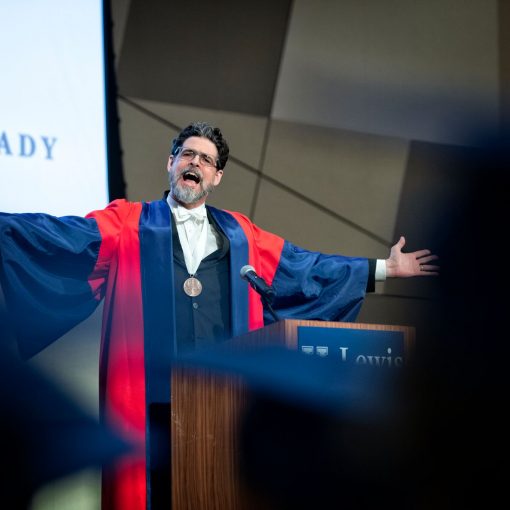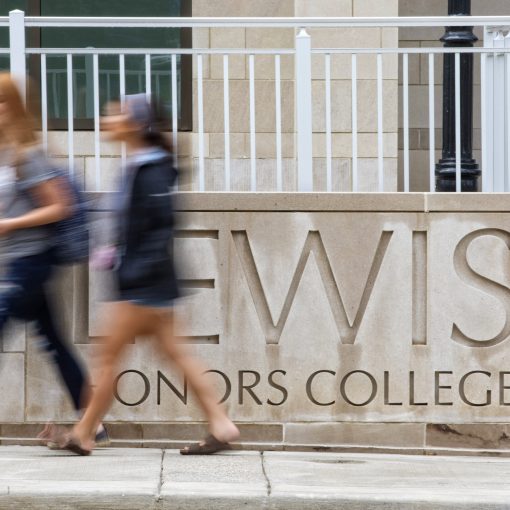Over the last year as our college and university engaged in developing our next strategic plan I have thought a lot about what it means to be a “land-grant university” in today’s world. Then I was invited to provide the keynote address to the annual meeting of the National Agricultural Alumni and Development Association. The theme of their conference was “Creativity Starts Here.” This essay has grown out of my remarks that evening and as such has particular reference to agriculture and its concerns.
Creating the Future We Want
Although I didn’t know it, my introduction to land-grant colleges and universities came when I was just 6 years old, tagging along with my brother to the Cooperative Extension office in Gaithersburg, MD to learn how to make bread. 4-H became a part of my life even before I was old enough to officially join. I did demonstration and informative speeches, canned goods, learned photography (still a passion of mine), kept rabbits and sheep, judged consumer goods and poultry. (I even stole my first few kisses while in 4-H and my brother found his wife at 4-H camp, as had our grandfather.) While my academic background may give the impression that I have never been anything other than a bookworm and having grown up outside of DC might suggest I am simply a typical suburbanite, the experiences I had through 4-H, FFA, and our county fair have been deeply formative in my life.
I loved that the school I went to, Cornell University, was the only Ivy League school that was also a land-grant university and when I arrived here at Penn State in 2006 the first thing I did was ask to see the poultry barns. On my short 4 miles to work I pass horses, experimental fields, poultry, dairy, swine, turf grass and meat science buildings. “Green Acres is the place for me (Farm livin’ is the life for me!).”
Back to our Roots
We all know the history. Our institutions, both collegiate and collegial, are founded upon the basic premise that our society needed to provide “a broad segment of the population with a practical education that had direct relevance to their daily lives.”[1] All of this, I might add given my own academic background, without “excluding other scientific and classical studies.”[2]
There are many today who question the very viability of public universities in today’s world and the reduction in state funding brings doubt as to the relationship between the words “State” and “University.” But I believe strongly that there is a future for a land grant institution in the 21st century, but we must reimagine what that means in this new era. I think this can best be done by remaining focused upon this original mission, even if the nation and the states and commonwealths allow their own support to wane.
Educational Access
The accessibility of education is at the heart of the Land Grant mission. At Penn State we have twenty undergraduate campuses. These arose in various ways (some acquired, some given to us by the commonwealth as part of a funding deal), but the general purpose was clear: to provide educational opportunities close to a person’s home. When you only have one campus in the middle of a large state attending classes requires you to stop all other activities for 9 ½ months out of the year. That immediately limits those who can pursue an education. For decades now our campus system has provided the opportunities in a unique system of “one university, geographically dispersed.”
The costs of such a campus system is not inexpensive and this is a specific challenge for Penn State going forward. Such a system, however, may not always need to exist in its present configuration. A physical presence will always be desired, but we can now deliver an education even closer to a students’ home, right to their desk. While there is much discussion about a “digital divide” and these concerns are real, most people today do have access to a computer and internet access, via their smart phones if not in the more traditional form of a laptop or desktop computer. Just this past week US News & World Report ranked Penn State’s World Campus’ bachelor program as number one in the nation. We offer more than 40 accredited undergraduate degree programs. This is where we are already leading our nation in defining the 21st century land-grant university.
The Cooperative Extension Service faces similar challenges. We have an agent in every county throughout the commonwealth and for good reason. Historically people have brought their soil samples directly to the office to be tested or met with their agent face-to-face in learning sessions and workshops. Programs like eXtension (how are we to pronounce that?) http://about.extension.org/about/ are beginning to offer a different, more flexible model.
Now, as much of a tech geek that I am, I do not believe the answer to every problem is online education. MOOCs have not replaced the university as some predicted. But we would be foolish not to embrace new tools and methods. That is, after all, precisely why our institutions were created in the first place, to educate our community in the best and newest practices available. We have a very bad habit in academia to continue on with our team of mules and steel plow rather than consider upgrading to a GPS guided modern farming equipment.
Innovation and Entrepreneurship
That leads me back to curriculum. In the academic side of the house, we have to continue to examine what it means to “promote the liberal and practical education of the industrial classes in the several pursuits and professions in life.” First, our “industrial classes” are no longer just in factories and farms. They are creating apps and working in the service industry, consulting and investing. A “practical education” today will ensure that our students are fully at ease in social media and communicating via video conference call.
It will also include preparing our students for an entrepreneurial world. President Barron just this week spoke about a new $30 million investment in “economic development and student support” focused upon taking our teaching and research expertise and developing it into products and careers.
By leveraging our size and broad research strengths, Penn State will be a driver for job creation, economic development and student career success. Our aim is to accelerate the transfer of new ideas into useful products and processes that encompass a broad range including: energy, food security, environmental protection, health care, manufacturing, educational technologies, medical devices and pharmaceuticals.
—President Eric Barron, Source
Only a small percentage of people will ever become a Steve Jobs or Mark Zuckerberg, but today we all need to understand how to adapt and innovate, the foundations of entrepreneurship. These things can be partly learned in a class room environment, but it is also has an organic and dynamic aspect that cannot be harnessed in a syllabus. We have various incubators and student groups at Penn State that we must continue to support and encourage, such as InnoBlue, a student organization that I am very proud to advise, but is entirely student run and managed. They need the classroom and faculty guidance, but they also learn as much through such organizations and we need to continue to foster those opportunities.
We Are…A Global University
We also should no longer think in a parochial manner. Yes, dairy is still a key industry in PA, but our university and our graduates are very much in a global market. For the last several years 10% of our incoming students at University Park campus have been international students. Some of our strongest programs located within Agricultural Sciences are international in breadth and focus and this is, of course, true across the university. The practical skills needed today include exposure and fluency in crossing cultures. Sometimes that is just across campus.
But while moving to online education for courses and extension may require (or be in response to) cultural change, we all know that there is another, greater challenge that we face.
Sometimes it really is about the money
At my very first Schreyer Honors College board meeting our chair and a close friend of Mr. Schreyer gave me some advice. “When people ask what you most need, never say, ‘Money.’” I asked, “What if that is the answer?” He said, find another way to say it.
The barrier to access is not geographic, it is financial. The reduction in offerings by our Extension service isn’t because our universities are no longer able to “extend,” in the words of the USDA, and solve “public needs with college or university resources through non-formal, non-credit programs.”[3] It is because the funding has diminished.
So what do we do?
First, we have to be tough. Penn State is perhaps in the best position among land-grant universities because we have been receiving diminished support from the Commonwealth for over 20 years. At PSU, state appropriations were surpassed by tuition revenue in the early 80s. In California that only occurred in the last 4 years. The result is that Penn State has adapted over the years in part by increasing tuition yielding one of the highest in-state tuition in the nation.[4] But along the way we have managed to maintain a strong and robust research program in agricultural sciences, a solid extension program, and kept all our campuses not only open, but in many cases expanded them. The result of that is that the legislature saw us coping just fine with a significantly smaller appropriation to us.
We have to be willing to make it clear that the programs that are funded and supported by federal, state, and local funds need those funds. If the support is reduced then the programs should be reduced. There ought to be consequences.
But no one likes a whiner.
There are times when we have to say that our students, our programs, our mission is more important than politics and the winds and whims of popularity. We need to reinterpret those foundational principles for a new millennium, determine our priorities, and then we need to set out to make them happen.
If we believe that these things are truly important then we need to step up and get others to do the same. And as much as our former board chair would prefer I not be so blunt, we need money to make them happen. So we have to help ourselves and as our recently completed capital campaign and our new president’s priorities demonstrate, Penn State and Penn Staters can and will set the example for the nation in supporting our students and their educational goals.
The history of land-grant institutions in the United States is a powerful and a proud one and the Pennsylvania State University is a central part of that history. We have an incredible story to tell. Sadly, people assume that it is all history, that it is all behind us. We know that there is a bright and exciting future before us.
Now we need to create that future, share it with others, and bring the world along with us.
[1] http://ext.wsu.edu/documents/landgrant.pdf
[2] “…without excluding other scientific and classical studies and including military tactic, to teach such branches of learning as are related to agriculture and the mechanic arts, in such manner as the legislatures of the States may respectively prescribe, in order to promote the liberal and practical education of the industrial classes in the several pursuits and professions in life.” http://www.law.cornell.edu/uscode/text/7/304
[3] http://www.csrees.usda.gov/qlinks/extension.html
[4] http://www.usnews.com/education/best-colleges/the-short-list-college/articles/2014/02/04/10-most-expensive-public-schools-for-in-state-studentsvv



